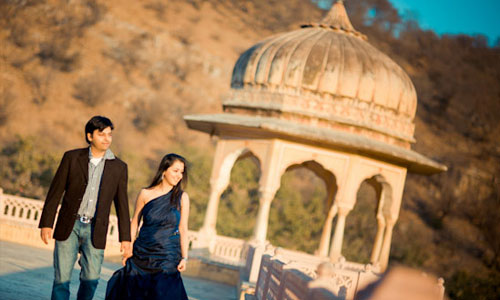Jantar Mantar Jaipur: The Excellent Example of Astrological Knowledge of Jaipur Rulers
Jantar Mantar of Jaipur is a planet observatory that was built by Mahraja Sawai Jai Singh in 1738 with the help of renowned architects and builders who were well-versed with the intricate and complex laws of architecture and planetary movements. The place is home to nineteen state of the art astronomical instruments. Impressed by its structure, functionality and heritage importance the UNESCO has declared it a World Heritage Site. The place also houses the largest Sundial of the world.
What is so special about Jantar Mantar’s Devices?
Depending upon the use and functional requirements various instruments are specifically designed. Some of them are built with stone while the others use brass as raw material. The selection of material is entirely based on several scientific and astronomical reasons. The process of making is based on the ideal instrument design principles that are mentioned in ancient Indian scriptures on astrological calculations. The instruments of the observatory facilitate a close observation of real time astronomical positions without the help of any vision magnifying instrument.
The astronomical instruments of Jantar Mantar can operate in 3 celestial coordinate systems as per the classical branch of astronomy: Equatorial System, Horizon-Zenith Local System and Ecliptic System. However, it is interesting to know that a specific device called Kapala Yantraprakara facilitates transformation from one system to the other. This is the finest example of astronomical excellence that India possessed even before the man put hi first step on the moon!
I am intrigued; can you tell me more about various devices?
There are as many as 18 devices in Jantar Mantar. Here is the information of some major devices:
- Chakra Yantra: The device is specifically designed to give declination of the Sun using 4 arcs that are semicircular in dimensions. A gnomn is positioned in such a way that its shadow is cast on the arc. Depending upon the shadow four specified times of the day can be measured. If the astronomical language is too heavy to understand, let us simplify it: You can actually tell the local time in different parts of the world at a specific moment.
- Dakshin Bhitti Yantra: This Yantra is used to measure distances of celestial bodies in terms of altitude, meridian and zenith distance.
- Digamasha Yantra: It is actually a pillar that stands in the middle of 2 concentric outer circles. It is specifically designed to calculate and forecast the times of sunrise and sunset. It is also used to measure the azimuth of the Sun.
- Dhruva Darshak Pattika: It is used to find the location of pole star relative to various other celestial bodies.
- Jai Prakash Yantra: It is a Sundial having 2 especially designed bowls. It has marked marble slabs that show inverted sky image. The observer can move inside the instrument and perform various activities like measuring altitudes, hour angles, declinations and azimuths.
- Kapala Yantra: Using its high end techniques you can visually transform any point in the sky from one coordinate system to another. It is used for measuring the celestial bodies' coordinates in equatorials systems and azimuth.
- Kranti Vritta Yantra: Its specific design helps in measuringthe longitude ad n latitude of the celestial bodies
- Laghu Samrat Yantra: This is another sundial at the monument that is inclined at 27 degree. However it lacks the precise accuracy of bigger sundial called vrihat samrat yantra
- Nadi Valaya Yantra: These 2 sundials are positioned on different faces of an instrument and represent the 2 hemispheres: north and south. Its time measuring accuracy is less than a minute
- Yanra raj Yantra: With the impressive dimensions of 2.43 meter, this astrolabe is counted among the world’s largest astrolabes. It is used to calculate the Hindu calendar and is used only once a year.
- Vrihat Samrat Yantra: It measures time using the principles of shadow casting formed by sunlight. It measures the time every 2 seconds. It is 88 Feet high and angled at 27 degrees. It is also used to announce the arrival of monsoons and eclipse announcements.
- Unnatasha yantra: This is a metal ring that is divided into 4 segments and has a hole in the middle. It is used to measure altitude of celestial bodies that depends upon the orientation and position of the instrument.
Other devices include Kanali Yantra, Misra Yantra, Palbha Yantra among the wide variety of astronomical devices.
Anything interesting tidbits?
The site has been used as a location for :
- Cover of shpongle's Live at the Roundhose 2008 Movies
- For the cover page of book Prosa del Observatories
- 2006 film The Fall
How to Reach
From Airport
Via Cab or Auto
- Distance from railway station is 11.9 km via Jawahar Lal Naharu (JLN Marg).
- Cab or auto will take 30-35 min to reach Jantar Mantar.
- Charges for one side is approx. for auto Rs. 120 to 150 Indian rupee.
- Charges for one side is approx. for cab Rs. 150 to 200 Indian rupee.
Via Public Transportation
- Bus service is available for Jantar Mantar.
- You can take auto and reach Jawahar Circle, than from Jawahar circle you can take bus AC-2 towards Joshi Marg, it will drop you at Badi Chopad from there 500m (15 minutes walking distance of JanterManter),
- It will take more than 1 hour.
- For Tickets & Information - +91 141 223 3509
From Railway Station
Via Cab or Auto
- Distance from railway station is 4.2 km (via Station Road).
- Cab or auto will take 15-20 min to reach Jantar Mantar.
- Charges for one side is approx. for auto 50 to 70 Indian rupee.
- Charges for one side is approx. for cab 70 to 100 Indian rupee.
Via Public Transportation
- Bus service is available for Jantar Mantar.
- You will reach Station Circle, than after that from Station Circle you will take bus Mini Bustowards Galta Gate, it will drop you at Tripolia Bazar from there 450 m (15 minutes walking distance),
- It will take 20-25 minutes.
Parking Information
- Parking available
- Charges – 20 to 30 Indian rupee per bike or car
- Contact info - 0141 408 8888












